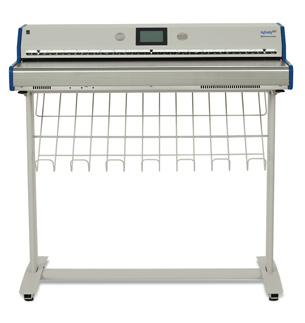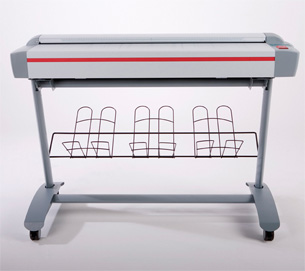Wide-Format Scanners
These indispensable document- and data-management devices are getting wider, faster, easier to use--and cheaper.
Latest News
May 3, 2009
By David Essex
 The Bowe Bell+Howell Infinity WF 36. |
For such a highly computerized profession, engineering is surprisingly behind the curve when it comes to capturing, archiving, and reusing information that exists only on paper. It’s a problem and an opportunity that wide-format scanners stand ready to address. With yearly improvements in convenience, quality, and price, there’s no excuse for even the smallest firm to not take a serious look.
Until now, charge-coupled device (CCD) cameras have been the preferred image-capture technology for large scanners. But the cheaper, usually lower-resolution alternative, contact image sensors (CIS—pronounced sis) have improved in recent years, according to scanner vendors, and are now usually the best choice for engineers.
Most people won’t need the higher resolutions and image quality of CCD and can save money with CIS, unless they have a lot of complex images to scan. While you will probably be satisfied with a monochrome or grayscale scanner, don’t rule out color, even if only a fraction of your documents contain it. The price premium is no longer a deal-killer, and color is like insurance: you don’t think you need it until you do.Scanning Spec Sheets
Size, resolution, speed, and price are the variables most likely to determine your final choice.
Wide format scanners typically come in 36-, 42-, and 48-in. widths, but some reach 52 in. and more. You also need to note the thickness of your typical (and potential) documents, drawings, and prints, and find a scanner that can accommodate the range.
Optical resolution, the truest measure of sharpness, denotes the precision of the image-capture device. The wide-format norm is 600 dots per inch (dpi). Some vendors claim higher resolutions that are interpolated through software. Interpolated resolutions are often derided as misleading advertising but are, in fact, useful, according to Penny Holland, director of business development at Océ. That’s because the highest resolutions produce significantly larger computer files than lower resolutions.
 The Colortrac SmartLF Gx+. |
“If you scan at 600-by-600 color, it won’t fit on a DVD,” Holland says. But scan at, say, 300 dpi while interpolating it to a higher resolution, and the scan will run faster, the file will fit better, and the eye probably won’t tell the difference.
There is no standard for reporting speed, or throughput, on spec sheets. So you must scrutinize the inches per second (ips) figures to find the speed-determining variables that most closely match your documents. Big, colorful documents with dense images take a lot longer to scan than smaller, simple monochromatic ones. One telling question to ask vendors: how much of the speed is measured at the scanner, and how much at the PC? Just because a scan finishes on the scanner doesn’t mean it is ready to manipulate on the PC, though it does mean the scanner is free for the next job. BERTL, which does independent evaluations of digital imaging devices, runs tests that use standardized benchmarks for speed.
Prices in the low end (narrowest widths, monochrome) have moved down from a year ago, and now average around $7,000, while the widest color scanners top out near $30,000.
Network connectivity is, of course, important for sharing documents. Most scanners now support USB, which not only provides a connection to most printers, but allows co-workers to share a scanner by outputting files to portable USB storage devices.
More scanners are going “green” by earning EnergyStar and RoHS certifications for their energy efficiency and elimination of certain hazardous materials from their manufacturing process. Power consumption is another spec to consider, but beware literature that quotes electricity use during standby rather than operating modes.
 The Oce CS4300. |
BÖWE BELL+HOWELL
Continuing to roll along with its 36-, 42-, and 48-in. Infinity WF series, BÖWE BELL+HOWELL touts the scanners’ speed, image quality, and ease of use. At 400dpi, the 36-inch model will scan a monochrome document at 12.6 ips, and color at 2.5 ips.
Starting at around $15,000, Infinity WF employs SharpShooter 600-dpi CCD cameras with white LEDs that provide instant scanning at power-up, says Jackie Horn, the company’s director of worldwide marketing. It also has automatic width detection. “There’s no need to tell the scanner the width of the document,” Horn says.
Colortrac
Maker of SmartLF Cx series CIS and Gx series CCD scanners, Colortrac—whose U.S. distributor is GEI WideFormat—tops the industry with its first 56-in. model, the SmartLF Gx+ 56.
New early this year is the Ci40, a 40-in., 600dpi CIS model. At under 50 pounds, the Ci40 is substantially lighter than most wide-format scanners, which can weigh nearly twice as much. One person can lift it, and it is more feasible to bring to remote sights, says Malcolm Lane, president of Colortrac’s Americas and Japan operations. Rather than having a straight-through paper path, the Ci40 returns the paper in the direction it was inserted, so you can put it against a wall. It starts at $6,195 for the 10ips monochrome/grayscale version, while the $7,995 color version outputs at an impressive 3.33ips.
Colortrac was planning to release in April what Lane says might be the best scanner yet for engineers, the SmartLF Gx+ series, true 1200-dpi, LED-based CCD models for $9,995 to $13,295. For an extra $1,000, it will scan documents thicker than 0.8 in.
Contex
Last June, Contex introduced a rarity for the company: a CIS unit, the 44-in. SD4400 series. All four models run at 1200dpi and are available in 24-bit color or monochrome at speeds up to 10ips. It also upgraded its Nextimage enhancement software, adding scan-to-e-mail, a new TWAIN driver with more export capabilities, seamless switching between the copy and scan-to-file options, and .DWF file compatibility with Autodesk software.
Until now, Contex had been almost exclusively a CCD company, says Dan Bennett, director of service operations for North and South America, but CIS has made major strides. Still, there are meaningful differences.
“One of the advantages of CCD is it has a very high bit depth,” Bennett says, adding CCD camera lenses have a deep focal length, and their fluorescent bulbs provide smooth, even light that minimizes shadows. “Because of that extra focal length, everything tends to stay in focus,” including folded documents, such as maps, and thick or rigid documents. With CIS, Bennett says, “the light is focused to the original. That brings out incredible details.”
CIS scanners also weigh less and use instant-on, light-emitting diodes (LEDs) that provide incredible brightness and detail with flat documents and, unlike fluorescent tubes, have virtually unlimited life. Bottom line: CCDs are required for graphics-intensive applications such as fine art, but can be overkill for engineering when CIS will do the same job for less.
The company’s higher-end, CCD scanners, the HD series, top out at $27,900 retail for the 54-in. HD5450.
Contex also makes Vidar scanners that have the same model-numbering scheme but are sold by different channel partners, and it OEMs scanners to such vendors and distributors as GTCO/Calcomp, HP, Ideal/Contex, and Océ.
Graphtec
Graphtec America sells four types of scanners, all of which use CIS technology. Its three series of 42-in. scanners have 600dpi optical resolution and scan speeds up to 9ips (monochrome) and 3 ips (color) at 400dpi. These are the IS210 series, the CS510 Full Color Large-Format Scanner, and the CS610 24-bit Full Color Large Format Scanner that has the ability to scan rigid originals up to 0.8 in. in thickness.
The company also sells the CSX300-09HD 24-bit color Face-Up Scanner that takes documents up to 36 in. It also has 600dpi optical resolution, but with scan speeds of up to 7ips (monochrome) and 2ips (color) at 400dpi.
Océ
In mid-2008, Océ debuted several new color scanners geared to technical environments. The CCD-based CS4300 line comes in 36-, 43-, and 54-in. sizes at 600dpi, while the CS4236, at 36-in., employs CIS to scan at an impressive 1200dpi optical resolution. Both are multifunction units that come with their own Océ printers. The company breaks from convention and shows scanner speeds in feet per minute. The CS4236, for example, outputs color at 5 ft. per minute (1ips), not exactly a screamer, but respectable at such eye-popping resolutions.
Océ also unbundled its 600dpi TC4 scanner from its printer to offer a stand-alone version.
The CS4236 and CS4300 come with Océ’s Copy Easy software, which besides letting you scan to file or print, provides rotating and cropping. Built into the scanners is Océ Image Logic software, algorithms that examine individual pixels to filter out extraneous material and even fill in broken lines from the original. Templates save common settings—say, black-and-white D-size documents—and optimize the scan with a single push of the start button.
Xerox
Xerox has two wide-format scanning systems, both handling documents up to 42 in. in width. The Wide Format Scan System has features like variable speed capabilities, concurrent scan and print functions to increase productivity, and is said to be more compact than most wide-format scanners, offering either a desktop configuration or a floor stand with casters.
It scans at speeds from 2ips to 4ips, has an optical resolution of 400dpi, and will handle originals up to 0.5 in. in thickness.
So will the XEScan Solution, but this system comes bundled with software. You get three options, including job accounting, scan-to-print, labeling, nesting, and paneling. It has monochrome or color scanning at speeds of 2, 4, or 8ips (depending on resolution), provides scan-to-file/digital archiving and walk-up scan-to-email functions, and also handles documents up to 0.5 in. in thickness.
More Info:
BERTL
Manalapan, NJ
BÖWE BELL+HOWELL
Wheeling, IL
Colortrac
Golden, CO
Contex
Alleroed, Denmark
GEI WideFormat
No. Canton, OH
Graphtec
Santa Ana, CA
GTCO/Calcomp
Columbia, MD
HP
Palo Alto, CA
Ideal/Contex
Rockville, MD
Océ
Trumbull, CT
Vidar
Alleroed, Denmark
Xerox Corporation
Rochester, NY
Freelance writer David Essex has covered information technology for 23 years. He was a BYTE editor and has written for Computerworld, PC World, and numerous other publications. Send e-mail about this article to [email protected].
Subscribe to our FREE magazine, FREE email newsletters or both!
Latest News
About the Author
DE’s editors contribute news and new product announcements to Digital Engineering.
Press releases may be sent to them via [email protected].






